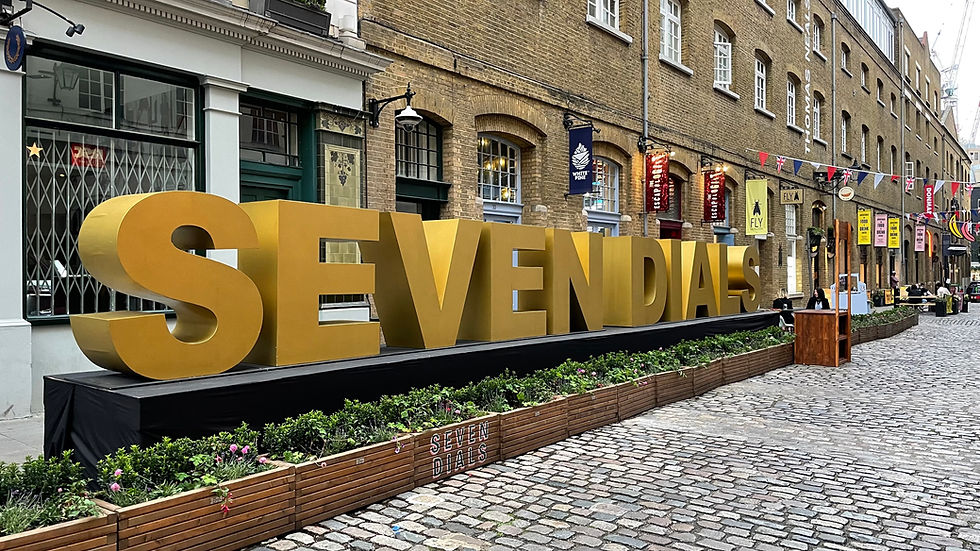Seven Dials through time...
- Angela Mata
- 26 de mar. de 2023
- 3 min de leitura

The roads within Seven Dials are an escape from the busy streets of the city and home to 90 stores including world-renowned international flagships and concept locations, beauty and grooming boutiques as well as over 50 contemporary cafes, restaurants, bars and pubs.
1690's
Seven Dials was originally laid out by Thomas Neale, MP in the early 1690's, who cleverly laid out the area in a series of triangles to maximise the number of houses as rentals were charged per foot of frontage and not per square foot of interiors.
1774
Monmouth Street (named after the unfortunate Duke of Monmouth, illegitimate son of Charles II, beheaded in 1685) became a centre for printers of ballads and political pamphlets. The star-shaped street plan and its sundial attracted occultists.
1800
By the middle of the eighteenth century the area had declined to the extent that 39 night-watchmen were needed to keep the peace. Bad behaviour centred around the Sundial, which the authorities removed in 1773. Rumours that a mob kncked it down looking for buried gold are, alas, untrue. If you want to see the original monument, visit Weybridge in Surrey, where it was re-erected in 1822.
1890
Without substantial investment into the public realm, the look of the area declined over the next 150 years but was nonetheless a thriving neighbourhood with a vibrant street market until the start of World War II.
1974
In the post war years both the population and commercial activity in the dials declined with resident numbers hitting their lowest point during the 1960´s. The streets were dominated by cars during this time. Without the Sundial creating a roundabout the centre of the dials was merely a junction without anywhere for people to rest and nothing to slow traffic down. There was even a petrol station on Earlham Street, cementing the idea that the space was for cars, not people.
1989
Born out of a highly successful Council led regeneration project in the late 1970's, the Seven Dials Trust was formally established in 1984 and quikly began the complex project of restoring the Sundial Pillar. In June 1989 the Sundial was unveiled by Her Majesty Queen Beatrix of the Netherlands. This important monument created a roundabout in the centre of the dials, slowing down traffic and providing an excellent new landmark.
As ruas que fazem parte da Seven Dials são uma fuga das ruas movimentadas da cidade e albergam 90 lojas, incluindo flagships internacionais de renome e locais conceptuais, boutiques de beleza, bem como mais de 50 cafés, restaurantes, bares e pubs contemporâneos.
1690
Seven Dials foi originalmente projetada por Thomas Neale, MP no início da década de 1690, que habilmente pensou a área numa série de triângulos para maximizar o número de casas, já que as rendas das mesmas eram cobradas por metro de fachada e não por metro quadrado do interior.
1774
A Monmouth Street (em homenagem ao infeliz Duque de Monmouth, filho ilegítimo de Charles II, decapitado em 1685) tornou-se um centro de impressão de baladas e panfletos políticos. A planta das ruas em forma de estrela e o seu relógio de sol atraíram os ocultistas.
1800
Em meados do século XVIII, a área havia diminuído a ponto de serem necessários 39 guardas noturnos para manter a paz. O mau comportamento concentrou-se em torno do Relógio de Sol, que as autoridades acabaram por remover em 1773. Rumores de que uma multidão o derrubou em busca de ouro ali enterrado são, infelizmente, falsos. Se quiserem ver o monumento original, visitem Weybridge em Surrey, onde foi reerguido em 1822.
1890
Sem investimentos substanciais no domínio público, a aparência da área decaiu nos 150 anos seguintes, mas ainda assim foi um bairro próspero com um vibrante mercado de rua até o início da Segunda Guerra Mundial.
1974
Nos anos do pós-guerra, tanto a população quanto a atividade comercial naquelas ruelas diminuíram, com o número de residentes atingindo o seu ponto mais baixo durante a década de 60. As ruas eram dominadas por carros durante essa altura. Sem o Relógio de Sol a formar uma rotunda, o centro era apenas um entroncamento sem lugar para as pessoas descansarem e nada para desacelerar o trânsito. Havia até um posto de gasolina na Earlham Street, consolidando a ideia de que o espaço era para carros, não para pessoas.
1989
Nascido de um projeto de regeneração liderado pelo Conselho altamente bem-sucedido no final dos anos 70, o Seven Dials Trust foi formalmente estabelecido em 1984 e rapidamente iniciou o complexo projeto de restauração do Sundial Pillar. Em junho de 1989, o Relógio de Sol foi inaugurado por Sua Majestade a Rainha Beatrix da Holanda. Este importante monumento criou uma rotunda bem no centro, diminuindo o tráfego e proporcionando um excelente novo marco.













































Comentários